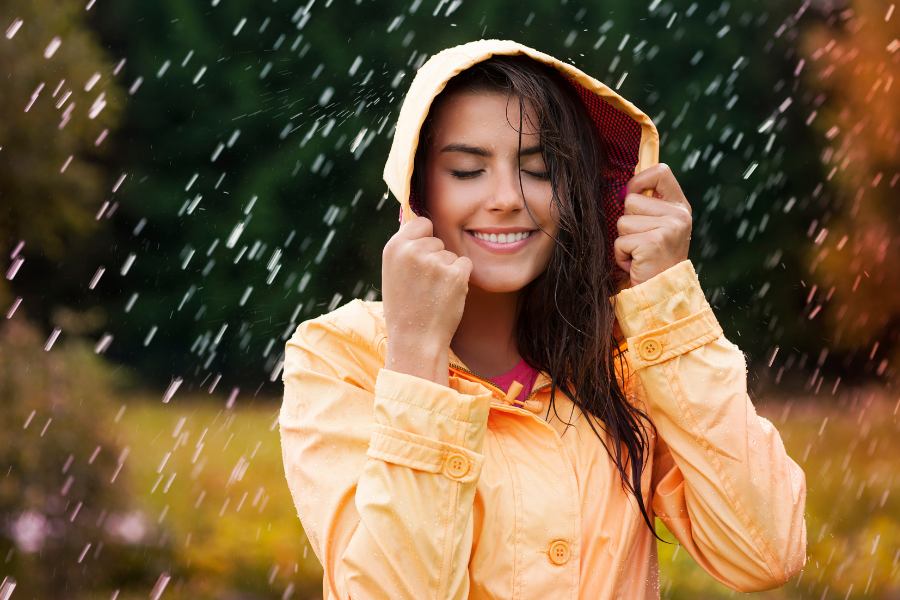Skin enthusiasts often swear by sunscreens, insisting on making it a part of their daily skincare routine. But is sunscreen important in monsoon too? Monsoons are cloudy and cool, the weather is pleasant and there’s no harsh sun to wreak havoc on your skin, right? Well, not really. Despite the cloudy weather, monsoon sun can harm the skin just as much as any other season. While you may choose to skip toning or applying masks and serums for added nourishment, using sunscreen is essential all year round. Adding a good sunscreen to your monsoon skincare routine is important to protect the skin from potential sun damage. In this post, we will discuss the importance of using sunscreen and how to choose the right sunscreen for your monsoon skincare routine.
How the Sun Affects the Skin During Monsoon
Cloudy weather might mean a pleasant climate, but the sun still shines, even if it’s above the clouds. If you think that the monsoon clouds work as some kind of curtain, protecting you from the sun’s UV rays, you’re quite mistaken. Monsoon sunrays might not burn the skin as the summer sun, but they are equally harsh. They cause just as much damage to the skin, leading to sunburn, premature aging, pigmentation, etc. Hence, it’s important to protect the skin even on overcast days. Sunscreens shield the skin from UV rays by forming a layer on the surface. They are the best way to protect the skin while also providing nourishment. Kamree’s Skin Brightening Kit consisting of a cleanser, face brightening serum, and a mineral sunscreen is the perfect addition to your monsoon skincare routine for healthy skin that radiates confidence.
Monsoon Skincare and Sunscreen
Sunscreens protect our skin from the sun by preventing the UV rays from reaching the skin directly. They form a layer on the skin that either deflects the sun’s rays or absorbs and then converts them into heat, dispersing them back into the environment. UV rays reach the earth in two forms: UVA and UVB rays. Most sunscreens offer SPF which protects from UVB rays. So, to get full protection from both types of UV rays, you should opt for a sunscreen that offers broad-spectrum protection. Broad spectrum sunscreens offer PA++ along with SPF. PA++ protects the skin from harmful UVA rays too. Hence, using sunscreen in monsoons is necessary for skin protection. By preventing the UV rays from affecting the skin, sunscreens can help prevent sun damage like sunburns, premature aging, hyperpigmentation, etc. A good broad-spectrum sunscreen with other nourishing ingredients can provide sun protection and also maintain overall skin health, regardless of weather conditions.
How to Choose the Right Sunscreen for Monsoon
Using sunscreen is important to get proper sun protection, irrespective of weather and season. However, depending on the skin’s individual needs, location, etc. the requirements of the sunscreen also change. When choosing a sunscreen for monsoon use, keep the following factors in mind for effective sun protection:
SPF Level
A Sun Protection Factor (SPF) of 30 or higher is necessary for effective sun protection for daily use. Higher SPF would offer higher protection which is beneficial in hot climate areas. When looking for sunscreen, take a look at the SPF level and ensure it’s 30 or higher.
Water Resistance
Monsoon weather means humidity, which can also cause excessive sweating. Water-resistant sunscreens can stay effective even underwater, in rain, or during excessive sweating.
Non-Comedogenic and Lightweight Formula
In your search for the right sunscreen, look for non-comedogenic and lightweight formulas. Non-comedogenic sunscreens won’t clog pores or cause acne and breakouts. Skin congestion is a big issue in monsoons as high humidity levels cause excess oil production and clogged pores. A lightweight, non-comedogenic sunscreen would get absorbed into the skin quickly and won’t feel heavy or greasy in the humid weather.
Broad-Spectrum Protection
Sunscreens should offer protection against both UVA and UVB rays. UVA rays can travel through glass too, so they can reach your skin even when you are indoors. Proper broad-spectrum sunscreen with both SPF and PA++ can guard your skin against UV radiation. Opt for a product that offers high coverage and full protection like Kamree’s Mineral Sunscreen gel.
Long-Lasting Formula
Sunscreens need frequent reapplication, usually within 3-4 hours, especially during outdoor activities, swimming, excess sweating, or in the rain. Opt for a sunscreen that provides long-lasting protection so that you don’t need to reapply frequently.
Skin Sensitivities and Allergies
For those with sensitive skin or skin allergies, some ingredients like fragrances, parabens, oxybenzone, etc. in the sunscreen may irritate the skin. Opt for sunscreens labeled as hypoallergenic or suitable for sensitive skin.
Conclusion
Sun’s harmful UV rays can reach our skin even through the clouds in the monsoon season. A broad-spectrum sunscreen can provide ample sun protection and also help maintain the skin’s overall health and vitality. Hence, regular use of sunscreen as a part of daily skincare routine is essential despite the seasons or weather conditions. So, don’t let your skin bear the brunt of sun rays. Prioritize sun protection in your monsoon skincare routine and enjoy soft, supple, and youthful radiance despite the rains!



